Co-Wear: Functional Fashion Co-Creation Method with People with Disabilities Enables the Development of Functional and Inclusive Fashion Garments
Bruna Brogin1* and Maria Lúcia Leite Ribeiro Okimoto2
1Post-Graduation Program in Design, Federal University of Paraná, Brazil
2Professor at Post-Graduation Program in Design, Federal University of Paraná, Brazil
Submission: July 4, 2019;Published: August 01,2019
*Corresponding author: Bruna Brogin, Post-Graduation Program in Design, Laboratory of Ergonomics and Usability, Federal University of Paraná, Avenue. Cel. Francisco H. dos Santos, 100, Jardim das Américas, Curitiba, Brazil
How to cite this article: Bruna Brogin, Maria Lúcia Leite Ribeiro Okimoto. Co-Wear: Functional Fashion Co-Creation Method with People with Disabilities Enables the Development of Functional and Inclusive Fashion Garments. Curr Trends Fashion Technol Textile Eng. 2019; 5(1): 555654. DOI: 10.19080/CTFTTE.2019.05.555654
Abstract
The Brazilian population is composed of 23.9% of people with disabilities. These citizens live in search of equal rights, possibilities and opportunities in relation to others. Designers can collaborate developing products that fit the body, needs and skills of this population, promoting autonomy, independence and quality of life. Fashion is a daily use product that can be designed to assist disabled users and their caregivers in the act of dressing and undressing. Co-Wear: Functional Fashion Co-creation Method was developed to bring together designers and people with disabilities in the development of functional and inclusive clothing. This work aimed at the application of the method with nine people with disabilities, developing a piece for each one and evaluating the usability of these products. Participants began to dress more independently, and those with total dependence were dressed faster and with less effort by their caregivers.
Keywords: Design; Inclusive fashion; Co-wear; Assistive technology
Introduction
In Brazil, according to the latest Census conducted by the Brazilian Institute of Geography and Statistics [1], 23.9% of the population has some deficiency, which represents around 45.6 million people. Of this percentage, 7% had motor deficiency (13,265,599 people according to [1]), which represents the second largest group of people with disabilities in the country. Assistive Technology is defined [2] as a wide range of equipment, services, strategies and practices designed and implemented to alleviate the problems encountered by people with disabilities. According to [3] the need for fashion products adapted to the needs of people with disabilities are real in Brazil, and are called Inclusive Fashion, whose goal is to provide inclusion, accessibility, autonomy, health, safety, comfort, self-esteem and quality of life to users. [4] calls these Functional Clothing Products, that is, focused on providing usability to people with disabilities. The design of fashion products with modeling, fabrics, trims and sizes appropriate to this population has been encouraged throughout the ten editions of the Inclusive Fashion Parade and the seventh editions of the Brazil South Award for Inclusive Fashion. In Brazil this theme has gained space in the fashion congresses (at the Colloquium of Fashion, for example) and even among lawyers, who have created a Fashion Rights sector, where Inclusive Fashion is the subject of discussions and lectures. The discussion of this theme has raised the need to create clothing products along with its users, since fashion designers sometimes lack knowledge about the aspects that permeate the abilities and fragilities related to each type of disability and disease in their different levels, and related to the context of each user.
In this way Co-Wear: Functional Fashion Co-creation Method [5] was developed to be used in a collaborative way among designers, disabled people, caregivers and health professionals interested in the project (doctors, physiotherapists, occupational therapists, social assistants). The purpose of this work is to apply Co-Wear with nine people with disabilities, developing a garment for each one, as well as evaluating the usability they present. This research is justified in the need to use and evaluate Co-Wear and the garments developed from its application. The diagnosis that the method is effective promotes its use in a broad way, as a teaching-learning tool in fashion schools and universities, as well as by companies in the fashion sector. The main themes that addressed this research are co-creation, the development of fashion products and the development of assistive technology products. [6] defines users’ co-creation as a process that allows them to express their requirements through physical attributes to the product and thus take care of the product development processes. According to [7] what motivates the participation of the co-creation is the experience with the appearance, the reach of the individuality, the possibility of an exciting experience and the obtaining of a unique product. Co-creation with people with disabilities has already been done by other researchers, such as by [8], who co-designed a language with people with aphasia, and [9], who co-created prostheses with amputated children in the lower limb. In the case of clothing [10] proposed a process of codesign and fashion development, which guides designers through six steps where they use design tools to co-create garments.
The [11] proposes a diagram of product development for people with disabilities that is based in four steps: explore, focus, develop and deliver. [12] present a method that proposes the development of assistive technology for people with disabilities through the Ergo design, the proposed steps are: problematization, data collection and analysis, product design, product evaluation and validation, design, production planning, production and usability evaluation. The Co-Wear Method, presented in Figure 1, was chosen to be used in this study because it encompasses in a method three areas: cocreation, fashion product development and assistive technology. The Method is composed of three phases, each with six stages, which break down in detail the development of the product. In addition, eighteen tools are suggested that contribute in the moments of co-creation, transferring fashion knowledge from the designer to the other co-creators, and design requirements and preferences of the co-creators to the designer, enabling the structuring of a product that meets the demands of the users
Materials and Methods
The characterization of this research consists of an applied nature study. According to [13] the approach is qualitative, that is, the focus is on the quality with which Co-Wear will be applied, allowing a maximum understanding of users’ needs, designing, prototyping and evaluating garments with them. According to the classifications the objectives of this study are exploratory, seeking to understand the interaction between each one of the cocreators and how the participations influence the quality of the final product. For the writing and grounding of this article, bibliographical research was conducted on themes that permeate the subjects covered here, such as inclusive and functional fashion, assistive technology, usability, ergonomics and comfort. Some major authors will be cited in this paper, since the emphasis is on the conduction of quasi-experiments conducted through the application of Co-Wear. [14] describes the quasi-experiments as systematized processes with controlled and independent variables, however, independent variables cannot be manipulated by the researcher. Control groups may not exist, and treatment groups may not be randomized. The quasiexperiments carried out in this study consist of the application of the Co-Wear design method with nine different groups of cocreators, through the researchers as design adviser responsible for the co-creation. All groups have at least one person with motor disability and a caregiver and may also involve interested family members and health professionals.
Table 1 summarizes the sample profiles, as well as their objectives with the co-creation, and the people involved in the co-creation, besides the researchers. After the invitation to participate in the research the participants signed a Term of Free and Informed Consent, the underage signed a Term of Free and Informed Assent, and the dates were set for the realization of the co-creation workshops. For each group of co-creators there were at least three workshops (one in the Pre-design stage, one in the Design stage, and one in the Prototyping and Evaluation stage), as established by Co-Wear (Figure 1, highlighted in green), up to five workshops depending on the cases that will be detailed in the sequence. In the third stage (Prototyping and Evaluation) the participants experimented the developed garments, if necessary, adjustments were made, the garments were experimented again, and then the co-creators answered a questionnaire evaluating the usability of the functional garments. Regarding the materials and methods used in the research, it is noteworthy that the workshops were carried out in the Ergonomics and Usability Laboratory of the Federal University of Paraná, and when requested were performed in other places, according to the participants’ preference. The Co-Wear Application Kit used was composed of a book for the development of the Method, tissue samples and trims, fashion trend figures, human body sketches, paper and pencil. The sequence of phase, stage and tools (Figure 1) were followed during the application of the method.
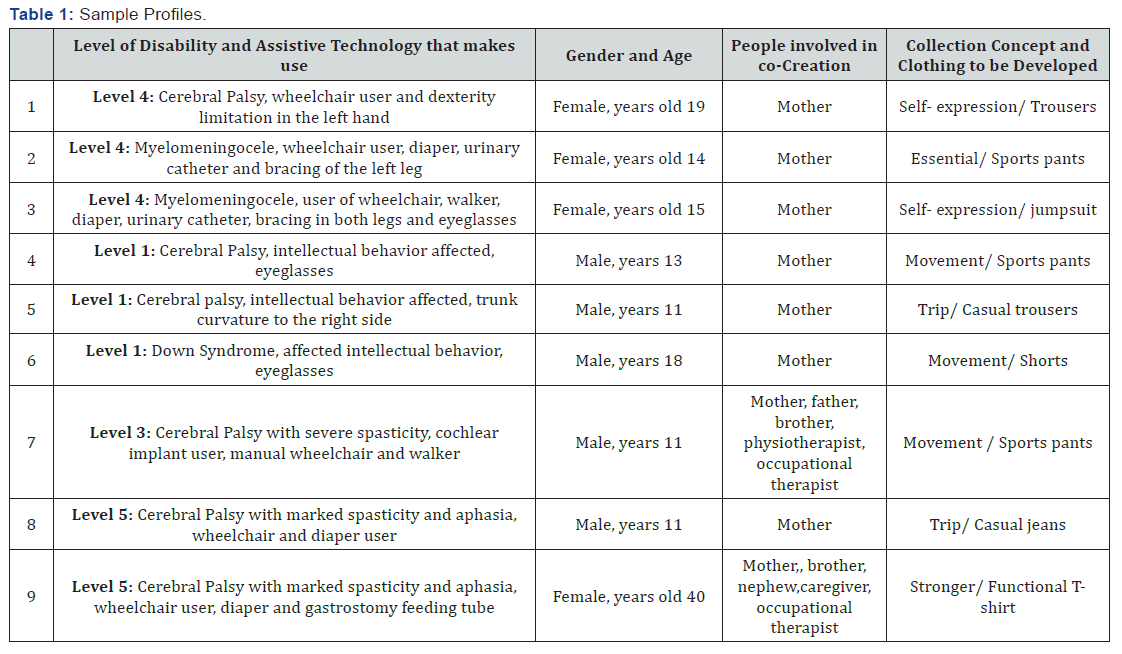
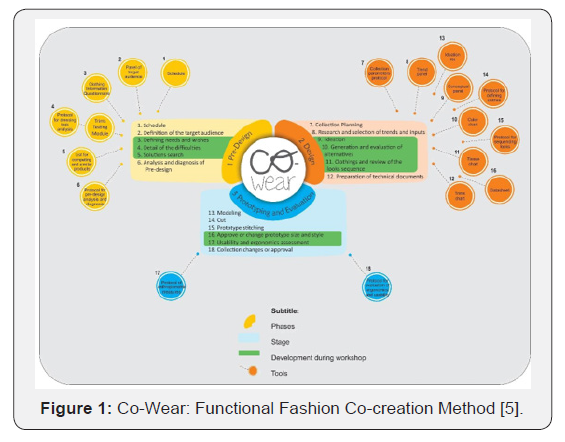
Results and Discussion
A service schedule was established for each disabled participant and their co-creators, each of whom was considered a co-creation team. Following, were developed Panels of Target Audience that are representative of the public in study, feminine (Figure 2) and masculine. The development of the timeline and the audience panel correspond respectively to Co-Wear’s first and second stages. Each person with a disability with their caregiver filled out the Clothing Information Questionnaire, a tool indicated for step three of Co-Wear. The main questions and answers are highlighted in the following. The routine activities of the participants were questioned in order to understand the context of wearing the clothes. The most recurrent responses were stay at home, artistic activities and go to school. Regarding the situation of the clothes used by people with disabilities, all responded that “The garments have specific adaptations due to the deficiency” or “The garments have no adaptation, but we would like them to have.” The mode of dressing, “standing”, “sitting” or “lying” was inquired, and for each option it could be marked “alone” or “with assistance”. In general people with severe disabilities reported that they are dressed in the lying position, wheelchair users are dressed seated, and people with mild or moderate disabilities dress up, alone or with assistance. Was asked about the movements made in dressing. The majority reported having difficulty tying shoelaces, zip closure and jeans buttons, and balancing upright to raise their pants up to their waist.
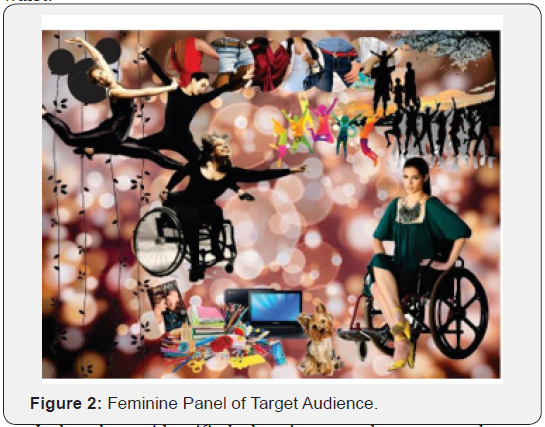
It has been identified that jeans and trousers, dresses, overcoats and jackets are the most difficult pieces of clothing models. Heavy tissues are uncomfortable for 8 of the 9 respondents. Shoelaces, buttons, zippers, and tags are the most difficult to handle or cause discomfort. As for the time required to wear, 70% indicated they spend 10 minutes or more to put their clothes on. It was identified that participants seek comfort in clothing, followed by functionality and variety. 45% indicated that garments in existing sizes serve, but require adaptations, another 45% indicate that tailor made clothing would be more effective. Six caregivers reported having health problems due to the care of the disabled person, being the most recurring pains in the back, and the feeling of tiredness and fatigue. In Step 4 of Co- Wear, Detail of the Difficulties, tool 4, Protocol for Dressing Task Analysis was applied. Participant 7 chose to co-create trousers, so he was assessed wearing unfitted sweatpants, performing the movements alone, sitting and standing, spending about five minutes to wear one cloth. The difficulty levels for each task were marked in the protocol, being it possible to emphasize the difficulty of balance, grip, lifting of the trousers up to the waist and tying of the shoelace. The analysis of this activity was accompanied by an Occupational Therapist, who gave tips for the project regarding the handle and better movements to be developed
The Trims Testing Module was applied with participants 1, 2, 3, and 6, and it was possible to perceive which actions were indicated and to be avoided for each participant. With the participants 4, 5, 8 and 9, these tools were not applied because they had already stated that they could not handle the work due to lack of fine dexterity. From Stage 5, Solutions Search, the Co-Wear List for Competitive and Similar Product was used. Solutions were collected in all the sites proposed in the tool, according to the need of each participant. The most relevant solutions were presented to the co-creators, who gave their opinions, facilitating the search for solutions for functional garments. In Stage 6, the Pre-Design Analysis and Diagnosis Protocol was used to list the main design requirements for each disabled participant. Priorities were defined regarding model, fabrics, trims, ergonomics, usability and sizes. Step 7 and tool 7 are related to Collection Planning. Because no collections were made, but only individual garments, the Collection Parameters Protocol was not applied. Following step 8 is the Research and Selection of Trends and Inputs. The designer has researched trends in fashion, fabrics, colors, textures, shapes, themes. Six main concepts were then defined and presented to the participants. Them each participant choose one according with the personal style and preference.
Four concepts were feminine: Stronger (classic), Self- Expression (playful), Essential (sports) and Op-Funny (creative). Two concepts were masculine: Movement (sport) and Travel (casual). The preferences of each disabled participant are described in Table 1. The conceptual panels and color charts developed are shown in Figure 3, according to the sequence described. As fashionable productive inputs are sometimes far from the knowledge of children, teenagers and caregivers, the researcher chose not to limit the use of garments and fabrics the pieces, so that the participants could choose. In this way a composition with more than one hundred sample of fabrics and their descriptions was elaborated, as well as a wide selection of trims. Instead of preselecting fabrics and supplies, the material was organized and prepared for the moments of co-creation, so that together all the co-creators could choose the best solutions. The second co-creation workshop begins in stage 9, Ideation. All the material developed was analyzed together: the pictures of functional garments that fit the profile of each participant, the pre-design analysis and diagnosis sheet, the trend panel, the conceptual panel and color chart, tissues and trims samples. Based on sketches of the human body present in tool 13, Kit Ideation, the possibilities were discussed, and the designer designed some models from the conversations, always focusing on design requirements and fashion information (Figure 4). Technical drawings explaining the pieces are part of the Ideation Kit and helped in the discussion of the garments.
Tool fourteen, Protocol for Defining Clothes, would be used to evaluate different pieces of clothing, to know which remains and which is eliminated from the collection. As in this research the proposal was to make a garment for each participant the protocol was used to evaluate different versions of the same piece. Each requirement of the model received a note (fabric, modeling, accessibility...) from the discussion among the co-creators. The sum of the notes defined the best alternative that followed in the project. Tool 15, Protocol for Sequencing Looks, was not used, since there was no variety of parts for composition. Before finalizing the second moment of co-creation the researcher collected the necessary anthropometric measurements of each participant who requested the making of tailored clothing. This procedure corresponds to step 13, Modeling, with the use of the Protocol of Anthropometric Measures (tool 17), for later accomplishment of the modeling. Participants 1, 2 and 3 were wheelchair users and were measured seated, since participants 2 and 3 were also overweight, the same measures were taken with them lying down. Participants 4, 5, 6, and 7 were measured standing. Participants 8 and 9 were measured sitting and lying in the position they could, due to difficulties in stretching the limbs. Returning to step 12, Preparation of Technical Documents, the technical data sheets of each clothes model were developed with the help of Corel Draw software.
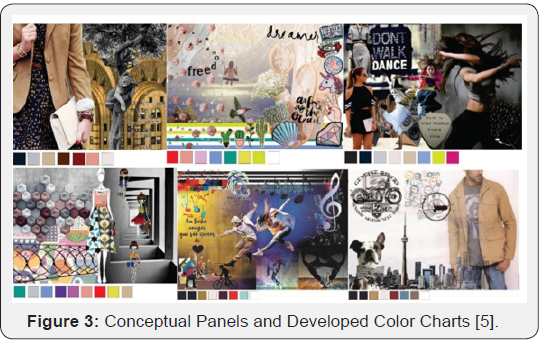
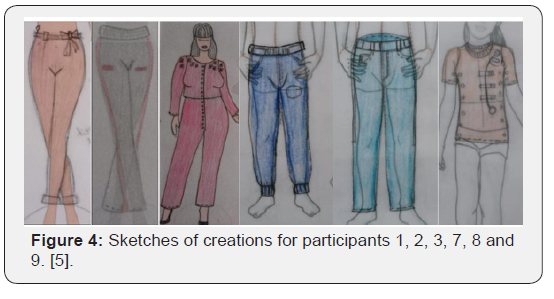
The parts (front and back) were designed as well as inserted the model and prototyping information (Figure 5). In step 14 the tissues of the respective models were cut. In step 15 the pieces were sewn with the help of sewing machines. The developed pieces are shown in Figure 6 in the ascending order of participants. For the first participant was developed black long trousers, with front pleats, high waistband on the back to cover the body due to the use of wheelchair, opening on both sides with closure by magnet buttons and Velcro. On the inner side of the trousers was a hooked satin ribbon for her to hold and pull her pants up to her waist. In front of the trousers a decorative tie was sewn, it and the belt, closed by two magnet buttons, were the same fabric of the pants, Piquet Span Comfort Knit. Participant two received a silver velvet trousers with red details, high back waistband next to the scar of the Myelomeningocele, large front pocket to fit the cell phone on the thighs, detail of rhinestones in the pockets, closure by thick elastic in the waistband. For participant three was developed a red long sleeve jumpsuit, with front opening to the end of the front crotch, with house buttons across the front center, with waistband elastic to fit the body and detail of lace in the front neckline. This model had to be adjusted three times until it reached the requested effect, being adjusted to the body and with enough opening for it to dress alone.

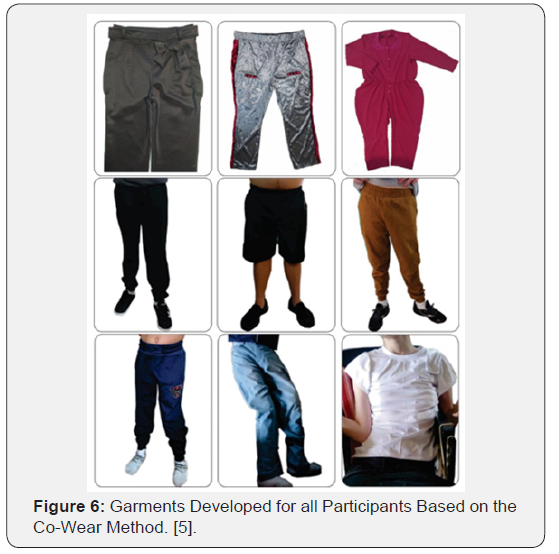
For the fourth participant was developed black sport pants tailored, since he was tall and thin. The model has ribbed waistband with internal elastic, without the presence of shoelaces that hindered the use of the piece. The participant five also had difficulties in the handling shoelaces, so it was developed a black short with wide elastic at the waist, allowing him to dress the piece without twist the shorts in the region of the buttocks. Participant six had difficulty identifying front and back, difficulty of balance, handling of the piece and the use of shoelaces. For him it was developed a jogger pant of Serge fabric in khaki color. The thick and firm elastic waistband made it easy to grip the trousers up to the waist and did not attach to the back of the body. The presence of a pocket on the back was explained, allowing him to identify front and back of the piece. Participant seven had difficulty balancing, picking up, lifting the piece on the body without curl in the lower part of the body, demanded pocket for handkerchief and apply with esthetic function. In the discussions with the Occupational Therapist, family and physiotherapists, it was decided, after two other prototypes, the insertion of a handle that facilitated the dressing. The trousers were in navy sweatshirt fleece with ribana and with thick elastic at the waist. On the ribbon were inserted were sewn handles, on the right and left side, that facilitated the fit of the hand and the upward movement of the piece on the body, with a single movement to the waist. Front and back pockets were inserted and skull appliqués that the participant requested.
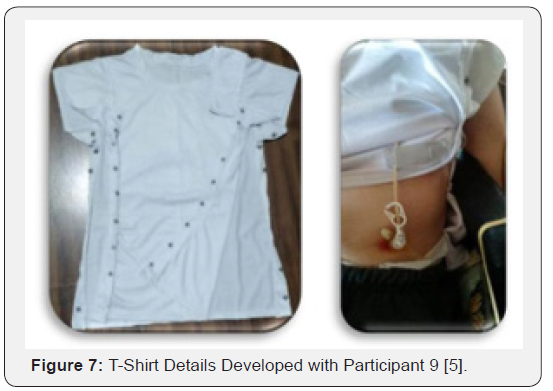
The piece developed for participant eight was a pair of jeans. In spite of the traditional appearance the jeans fly was kept, but did not open, not allowing the opening through the center of the piece, but by the sides with zippers that went down to the knees, facilitating the diaper change. Where the zipper’s cursor stopped, at the waist, there was a shield not to allow the skin to be pressed. The waistband contained an inner elastic, keeping the garment tight at the waist. Due to the participant being thin the pants had elastane, being adjusted to the body. The waistband of the pants was developed higher on the back, allowing it to accompany the curvature of the seated body, since he was a wheelchair user. The piece of clothing developed with the ninth co-creation team was a T-shirt that allowed the use with gastric feeding tube. The shirt was double on the front, with a shorter undershirt than an apparent T-shirt. This inner shirt was developed with three flaps that are closed by Velcro. Through these flaps the feeding tube could be led to the top of the piece up to shoulder height, where it leaves the front of the blouse, allowing easy access to food. An external protective flap closed by Velcro was inserted, so that the opening was not visible. The side of the entire T-shirt was opened by metal pushbuttons, making it easier to dress with the caregiver’s help, due to the rigidity and spastic movements that the participant presented. The neckline is finished with ribbon and the jersey is white Poly Viscose (Figure 7).
In step 16, Approve or Change Prototype Size and Style, the garments were tested on disabled participants during the third co-creation workshop. The necessary adjustments were marked by the researcher with pins. Details that needed adjustments were noted to be corrected. For four garments size adjustments were not necessary, all of participants with mild or moderate deficiency. For the others, adjustments and new tests were necessary, which occurred at another time, in workshop 4. In this fourth or fifth meeting, with the piece adjusted and approved in size and style by the co-participants, step 17, Usability and Ergonomics Assessment was carried out, using the Protocol for Evaluation of Ergonomics and Usability. From the conversations the garments could be “changed”, “approved”, or “disapproved” in step 18.
The protocol used to evaluate ergonomics and usability was based on [15] and presented the following criteria: a. Size b. Body trim c. Finishing (seams and finishes) d. Consistency with concept and style e. Dress and undress management f. Handling of trims (handle, materials, mobilities, quality, cleaning, instructions) g. Clarity of function and use h. Safety of the model, fabrics and trims i. Comfort (touch, weight and fabric trim, model, cut, flexibility and elasticity)
The criteria could be marked in three options: “disapproved”, “merited corrections” or “approved”. All criteria were approved by all participants in the delivery of the final prototype, and the garments are approved for usability, ergonomics and comfort
Conclusion
As for the theme, inclusive and functional fashion, its scientific relevance applied to the adaptation of clothing for people with disabilities, as proposed [16], is inevitable in the development of clothing for hospitalized people, as developed by [17], in the development of inclusive trims, as described by [18] and [19], and in the co-creation of fashion product, as in the case of this research. The goal was to apply the Co-Wear: Functional Fashion Co-creation Method with nine people with disabilities, developing a garment for each one and evaluating the usability of such pieces. The objective was achieved with a research carried out over a year, with the realization of several prototypes and evaluation of the final pieces. The applied method was able to explore the context of people with disabilities and their caregivers in the interaction with garments. The phases, stages and tools that are part of the Co-Wear Method were able to lead the researchers and co-creators during the development process of the garments. They also facilitated the exchange of information among the participants and collaborated so that the information collected was not ignored during the project but used in the creation stages. The Prototyping and Evaluation Phase was fundamental for improvements to be implemented with feedback from the participants, without being carried out arbitrarily by the researchers.
The method used collaborated so that the garments were developed in the appropriate sizes, with appropriate fabrics and trims, with the finishes chosen by the participants, and in the models that provide greater autonomy to the users and easier handling to the caregivers, avoiding laborious activities. The participation of health professionals during the co-creation moments proved to be effective, bringing expert opinions and functional ideas to the project, especially in those in which the participants had a severe disability. Their participation is recommended in future Co-Wear applications. All the participants affirmed that they started to dress with more autonomy with the co-created clothes or that they take less time wearing themselves with the functional garments than with similar without functionality. With the aging population in Brazil [1] the tendency is that soon more and more people will benefit from functional and inclusive fashion collections. Future work can study Co-Wear as a tool to be applied in companies that develop fashion, contributing to the insertion of functional and inclusive garments in all clothing niches.
Acknowledgements
We thank the Council for Improvement of Higher Education Personnel in Brazil (CAPES), the National Council for Scientific and Technological Development of Brazil (CNPQ) and Erasmus Euro Brazilian Plus for the funding of this research.
References
- Brazilian Institute of Geography and Statistics - IBGE (2010) Demographic Census 2010: General Characteristics of the Population, Religion and People with Disabilities. São Paulo: IBGE.
- Cook AM, Polgar JM (2014) Assistive Technologies: Principles and Practices. (4th edn), St. Louis, Mosby, Missouri, USA.
- Auler D, Sanches G (2017) (9th Edn) Concurso Moda Inclusiva. São Paulo: Estação Das Cores E Letras; Secretaria De Estado Dos Direitos Da Pessoa Com Deficiê
- Gupta, Deepti (2011) Functional Clothing – Definition and Classification. Indian Journal of Fiber and Textile Research, India, 36(4): 321-326.
- Brogin, Bruna (2019) Método De Design Para Cocriação De Moda Funcional Para Pessoas Com Deficiê Curitiba. Phd thesis Submitted to the Post-Graduate Program in Design of the Federal University of Paraná, Brazil, pp. 411.
- Von Hippel E (1998) Economics of Product Development by Users: The Impact of “Sticky” Local Information. Management Science, United States, 44(5): 629-644.
- Fiori AM, S-E Lee, Kunz G (2004) Individual Differences, Motivations, and Willingness to use a Mass Customization Option for Fashion Products. European Journal of Marketing, UK, 38(7): 835-849.
- Wilson S, Roper A, Marshall J, Galliers JR, Devane N, et al. (2015) Codesign for People with Aphasia Through Tangible Design Languages. CoDesign, UK, 11(1): 21-34.
- Hussain S, Sanders B.-N (2012) Fusion of Horizons: Co-Designing with Cambodian Children Who have Prosthetic Legs, Using Generative Design Tools. Codesign, UK, 8(1): 43-79.
- Hur E, Beverley K, Cassidy T (2013) Development of an Ideation Toolkit Supporting Sustainable Fashion Design and Consumption. Research Journal of Textile and Apparel, Emerald Publishing, England, UK, 17(2): 89-100.
- Norway Design Council (2010) Innovating with People: The Business of Inclusive Design. Norway: Norsk Designrad.
- Maia FN, Freitas SF (2014) Proposta De Um Fluxograma Para O Processo De Desenvolvimento De Produtos De Tecnologia Assistiva. Caderno De Terapia Ocupacional. UFSCAR, São Carlos 22(3): 561-567.
- Silva EL, Menezes EM (2005) Metodologia da pesquisa e Elaboração de Dissertaçã (4th edn) rev. atu. Florianópolis: UFSC.
- Barnes L, et al. (2012) Experimental and Quasi-Experimental Research. Writing@CSU Guide, The Writing Studio. Fort Collins: Colorado State University, Colorado, USA.
- Martins SB (2005) O conforto no vestuário: uma interpretação da ergonomia: metodologia de avaliação de usabilidade e conforto no vestuá Florianópolis, SC, Brazil.
- Theis MR, Tarachucky L, Mardula E (2015) Metodologia de modelagem cartesiana e ergonomia aplicadas na construção de figurinos de dança adequados para pessoas com necessidades específicas. Estudos em Design Revista online, Rio de Janeiro 23(3): 112-125.
- Santos HN, Rezende EJC, Araújo DIS (2014) A Influência Do Design no Desenvolvimento De Vestuário Hospitalar Para Pacientes. Estudos Em Design Revista Online, Rio De Janeiro 22(2): 63-79.
- Schneide J, Ferreira MGG, Ramirez ARG, Santos CT (2017) Etiquetas Têxteis Em Braille: Uma Tecnologia Assistiva a Serviço da Interação Dos Deficientes Visuais com a Moda e o Vestuá Estudos Em Design Revista Online, Rio De Janeiro 25(1): 65-85.
- Marchi SR, Smythe KCS, Okimoto MLLR, Paredes RSC (2018) Critérios para o desenvolvimento de sistema de código cromático para pessoas cegas ou com baixa visã In: Brazilian Congress on Research and Development of Assistive Technology (CBTA) II Regional Meeting of Attention to the Disabled Person (ERPAPD), Bauru, SP, Brazil, 6: 341-350.






























